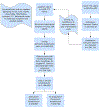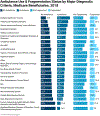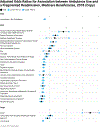Ambulance use and subsequent fragmented hospital readmission among older adults
- PMID: 36573624
- PMCID: PMC10175179
- DOI: 10.1111/jgs.18210
Ambulance use and subsequent fragmented hospital readmission among older adults
Abstract
Background: Interhospital care fragmentation, when a patient is readmitted to a different hospital than they were originally discharged from, occurs in 20%-25% of readmissions. Mode of transport to the hospital, specifically ambulance use, may be a risk factor for fragmented readmissions. Our study seeks to further understand the relationship between ambulance transport and fragmented readmissions in older adults, a population that is at increased risk for poor outcomes following fragmented readmissions.
Methods: We analyzed inpatient claims from Medicare beneficiaries in 2018 who had a hospital admission for select Hospital Readmission Reduction Program Conditions (acute myocardial infarction, congestive heart failure, chronic obstructive pulmonary disease, pneumonia) as well as dehydration, syncope, urinary tract infection, or behavioral issues. We evaluated the associations between ambulance transport and a fragmented readmission using logistic regression models adjusted for demographic, clinical, and hospital characteristics.
Results: The study included 1,186,600 30-day readmissions. Of these, 46.8% (n = 555,847) required ambulance transport. In fully adjusted models, taking an ambulance to the readmission hospital increased the odds of a fragmented readmission by 38% (95% CI 1.32, 1.44). When this association was examined by readmission major diagnostic category (MDC), the strongest associations were seen for Factors Influencing Health Status and Other Contacts with Health Services (i.e., rehabilitation, aftercare) (AOR 3.66, 95% CI 3.11, 4.32), Mental Diseases and Disorders (AOR 2.69, 95% CI 2.44, 2.97), and Multiple Significant Trauma (AOR 2.61, 95% CI 1.56, 4.35). When the model was stratified by patient origin, ambulance use remained associated with fragmented readmissions across all locations.
Conclusions: Ambulance use is associated with increased odds of a fragmented readmission, though the strength of the association varies by readmission diagnosis and origin. Patient-, hospital-, and system-level interventions should be developed, implemented, and evaluated to address this modifiable risk factor.
Keywords: Medicare; ambulance; care fragmentation; older adults; readmission.
© 2022 The American Geriatrics Society.
Conflict of interest statement
ST and MKA have received funding from Merck & Co. for research unrelated to this work.
Research reported in this publication was supported by the National Institute on Aging of the National Institutes of Health under Award Number K23AG065505 and by the Program for Retaining, Supporting, and EleVating Early-career Researchers at Emory (PeRSEVERE) from the Emory School of Medicine, a gift from the Doris Duke Charitable Foundation, and through the Georgia CTSA NIH award (UL1-TR002378). This material is the result of work supported with resources and the use of facilities at the Atlanta VA Health Care System. The content is solely the responsibility of the authors and does not necessarily represent the official views of the National Institutes of Health or the Department of Veterans Affairs. The sponsors had no role in the design, methods, subject recruitment, data collection, analysis, or preparation of the manuscript.
Figures




Similar articles
-
Association of Fragmented Readmissions and Electronic Information Sharing With Discharge Destination Among Older Adults.JAMA Netw Open. 2023 May 1;6(5):e2313592. doi: 10.1001/jamanetworkopen.2023.13592. JAMA Netw Open. 2023. PMID: 37191959 Free PMC article.
-
The Impact of Health Information Exchange on In-Hospital and Postdischarge Mortality in Older Adults with Alzheimer Disease Readmitted to a Different Hospital Within 30 Days of Discharge: Cohort Study of Medicare Beneficiaries.JMIR Aging. 2023 Mar 10;6:e41936. doi: 10.2196/41936. JMIR Aging. 2023. PMID: 36897638 Free PMC article.
-
Association between interhospital care fragmentation, readmission diagnosis, and outcomes.Am J Manag Care. 2021 May 1;27(5):e164-e170. doi: 10.37765/ajmc.2021.88639. Am J Manag Care. 2021. PMID: 34002968
-
Patient Outcomes Following Interhospital Care Fragmentation: A Systematic Review.J Gen Intern Med. 2020 May;35(5):1550-1558. doi: 10.1007/s11606-019-05366-z. Epub 2019 Oct 17. J Gen Intern Med. 2020. PMID: 31625038 Free PMC article.
-
The Effectiveness of Transition Interventions to Support Older Patients From Hospital to Home: A Systematic Scoping Review.J Appl Gerontol. 2021 Nov;40(11):1628-1636. doi: 10.1177/0733464820968712. Epub 2020 Nov 6. J Appl Gerontol. 2021. PMID: 33155499
Cited by
-
Care fragmentation and readmission mortality and length of stay before and during the COVID-19 pandemic: data from the National Readmissions Database, 2018-2020.BMC Health Serv Res. 2024 May 14;24(1):622. doi: 10.1186/s12913-024-11073-1. BMC Health Serv Res. 2024. PMID: 38741088 Free PMC article.
-
Association of Fragmented Readmissions and Electronic Information Sharing With Discharge Destination Among Older Adults.JAMA Netw Open. 2023 May 1;6(5):e2313592. doi: 10.1001/jamanetworkopen.2023.13592. JAMA Netw Open. 2023. PMID: 37191959 Free PMC article.
-
Assessing the environmental impact associated with disruptive surgical bleeding.Surg Open Sci. 2025 Apr 29;26:54-60. doi: 10.1016/j.sopen.2025.04.009. eCollection 2025 Jun. Surg Open Sci. 2025. PMID: 40458299 Free PMC article.
-
Fragmented Readmissions From a Nursing Facility in Medicare Beneficiaries.J Appl Gerontol. 2024 Nov;43(11):1762-1771. doi: 10.1177/07334648241254282. Epub 2024 May 26. J Appl Gerontol. 2024. PMID: 38798097 Free PMC article.
References
Publication types
MeSH terms
Grants and funding
LinkOut - more resources
Full Text Sources

